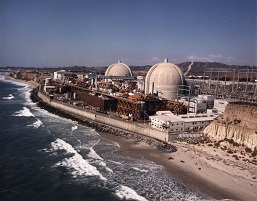Southern California Edison Announces Plans to Retire San Onofre Nuclear Generating Station
Company Will Continue Its Work with State Agencies on Electric Grid Reliability
A conference call with Q&A was held by management at 12PM EST Friday for media outlets only - replay will be available at 1-888-568-0503 (USA) and 1-203-369-3476 (International), passcode 5241.
ROSEMEAD, Calif.--(BUSINESS WIRE)-- Southern California Edison (SCE) has decided to permanently retire Units 2 and 3 of its San Onofre Nuclear Generating Station (SONGS).
"SONGS has served this region for over 40 years," said Ted Craver, Chairman and CEO of Edison International, parent company of SCE, "but we have concluded that the continuing uncertainty about when or if SONGS might return to service was not good for our customers, our investors, or the need to plan for our region's long-term electricity needs."
Both SONGS units have been shut down safely since January 2012. Unit 2 was taken out of service January 9, 2012, for a planned routine outage. Unit 3 was safely taken offline January 31, 2012, after station operators detected a small leak in a tube inside a steam generator manufactured by Mitsubishi Heavy Industries (MHI). Two steam generators manufactured by MHI were installed in Unit 2 in 2009 and two more were installed in Unit 3 in 2010, one of which developed the leak.
In connection with the decision, SCE estimates that it will record a charge in the second quarter of between $450 million and $650 million before taxes ($300 million - $425 million after tax), in accordance with accounting requirements.
After months of analysis and tests, SCE submitted a restart plan to the Nuclear Regulatory Commission (NRC) in October 2012. SCE proposed to safely restart Unit 2 at a reduced power level (70 %) for an initial period of approximately five months. That plan was based on work done by engineering groups from three independent firms with expertise in steam generator design and manufacturing.
The NRC has been reviewing SCE's plans for restart of Unit 2 for the last eight months, during which several public meetings have been held. A recent ruling by an adjudicatory arm of the NRC, the Atomic Safety and Licensing Board, creates further uncertainty regarding when a final decision might be made on restarting Unit 2. Additional administrative processes and appeals could result in delay of more than a year. During this period, the costs of maintaining SONGS in a state of readiness to restart and the costs to replace the power SONGS previously provided would continue. Moreover, it is uneconomic for SCE and its customers to bear the long-term repair costs for returning SONGS to full power operation without restart of Unit 2. SCE has concluded that efforts are better focused on planning for the replacement generation and transmission resources which will be required for grid reliability.
"Looking ahead," said Ron Litzinger, SCE's President, "we think that our decision to retire the units will eliminate uncertainty and facilitate orderly planning for California's energy future."
Litzinger noted that the company has worked with the California Independent System Operator, the California Energy Commission and the California Public Utilities Commission in planning for Southern California's energy needs and will continue to do so.
"The company is already well into a summer reliability program and has completed numerous transmission upgrades in addition to those completed last year," Litzinger said. "Thanks to consumer conservation, energy efficiency programs and a moderate summer, the region was able to get through last summer without electricity shortages. We hope for the same positive result again this year," Litzinger added, "although generation outages, soaring temperatures or wildfires impacting transmission lines would test the system."
In connection with the retirement of Units 2 and 3, San Onofre anticipates reducing staff over the next year from approximately 1,500 to approximately 400 employees, subject to applicable regulatory approvals. The majority of such reductions are expected to occur in 2013.
"This situation is very unfortunate," said Pete Dietrich, SCE's Chief Nuclear Officer, noting that "this is an extraordinary team of men and women. We will treat them fairly." SCE will work to ensure a fair process for this transition, and will work with the Utility Workers Union of America (UWUA) and the International Brotherhood of Electric Workers (IBEW) on transition plans for the employees they represent.
SCE also recognizes its continuing safety responsibilities as it moves toward decommissioning of the units. SCE's top priority will be to ensure a safe, orderly, and compliant retirement of these units. Full retirement of the units prior to decommissioning will take some years in accordance with customary practices. Actual decommissioning will take many years until completion. Such activities will remain subject to the continued oversight of the NRC.
SCE intends to pursue recovery of damages from Mitsubishi Heavy Industries, the supplier of the replacement steam generators, as well as recovery of amounts under applicable insurance policies.
For updates, please visit www.SONGScommunity.com, or follow us on Twitter at www.twitter.com/SCE_SONGS and on www.facebook.com/SCE.
San Onofre is jointly owned by SCE (78.21 percent), San Diego Gas & Electric (20 percent) and the city of Riverside (1.79 percent).
About Southern California Edison
An Edison International (NYSE: EIX ) company, Southern California Edison is one of the nation's largest electric utilities, serving a population of nearly 14 million via 4.9 million customer accounts in a 50,000-square-mile service area within Central, Coastal and Southern California.


